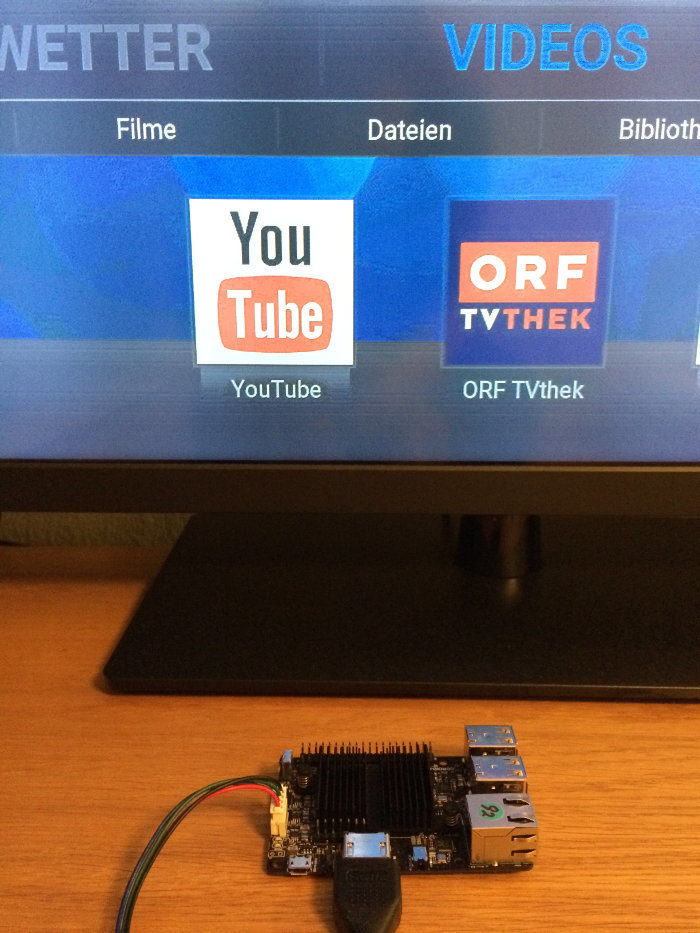Announced ARM64 board for developers (and fans) for $ 40 Odroid-C2 on Amlogic S905
Good afternoon, dear readers!
It is strange that there has not yet been a short news about this, so I’ll undertake to write. Last week, Hardkernel, who was mostly familiar with the production of dev-boards based on arm processors from different manufacturers (mainly Samsung Exynos and Amlogic, but they also had a full-size analogue RPi of a smaller format, which they were firmly pressed to release), announced the release of a new Odroid-C2 based on Amlogic's 64-bit ARM S905 processor.
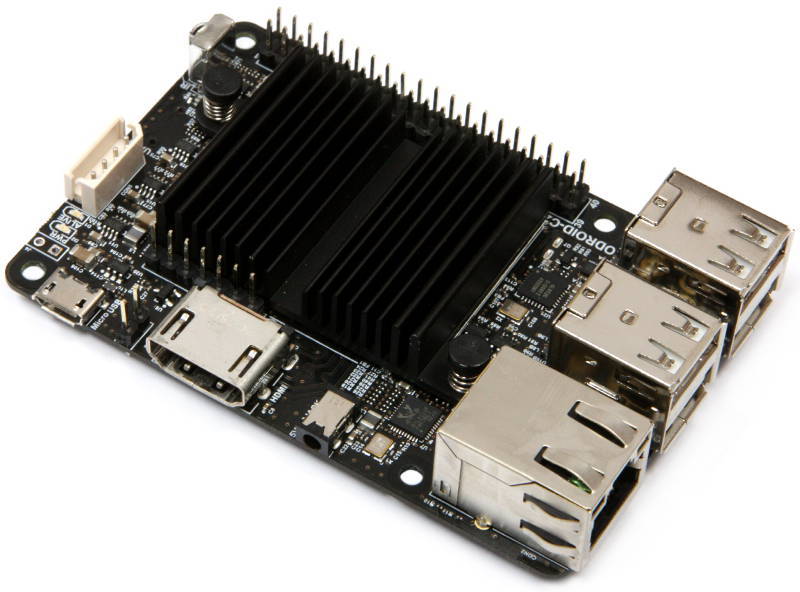
Despite the fact that nothing has been said about the new board on the official website, all information about it is already available. And the fact that the board is developed and debugged, and is half a step away from production, is quite obvious. As well as the fact that pre-orders open at the beginning of March in a month will already begin to be delivered. Therefore, without delay, the
details:
Well, about Geek's iron and Geek's story, here it is, all that techno-porn that was written on the forum by a company representative, and a few personal impressions (from a living sample on hand) at the very end.
ODROID-C2 is a 64-bit four-processor single-board computer, one of the most effective 64-bit computers for developers available in the world of ARM at the moment.
Will be available for purchase on March 2, 2016 at a price of $ 40. Mass production will begin on February 15th, the first shipments on March 4th.
Specifications:
Amlogic S905 (ARM® Cortex®-A53 (ARMv8) 2Ghz quad core CPU)
2Gbyte DDR3 SDRAM
ARM Mali ™ -450 MP3 GPU (OpenGL ES 2.0 / 1.1 for Linux and Android)
HDMI 2.0 4K / 60Hz display
H.265 4K / 60FPS and H.264 4K / 30FPS capable VPU
Gigabit Ethernet
40 + 7pin GPIO port
eMMC5.0 HS400 Flash Storage slot / UHS-1 SDR50 MicroSD slot
USB 2.0 Host x 4, USB 2.0 OTG x 1 (power + data capable)
Infrared (IR) Receiver
Ubuntu 16.04 and Android 5.1 Lollipop based on Kernel 3.14 LTS
Dimensions identical to ODROID-C1 +
Block diagram:
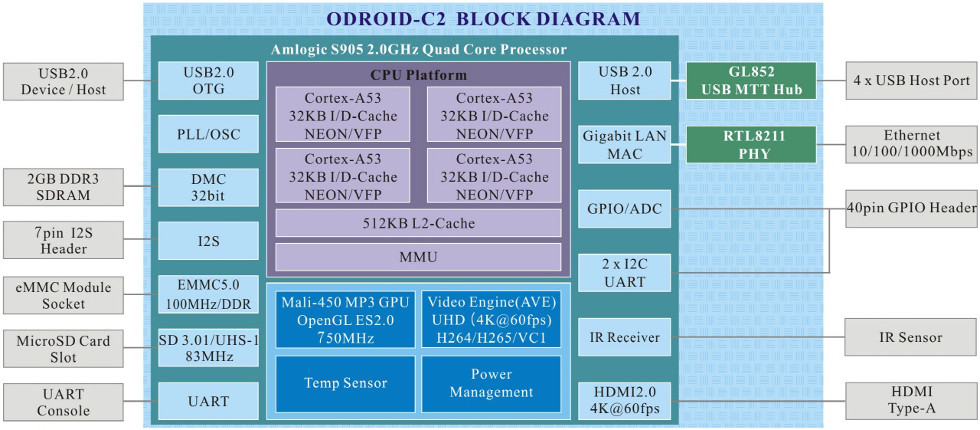
Main components:
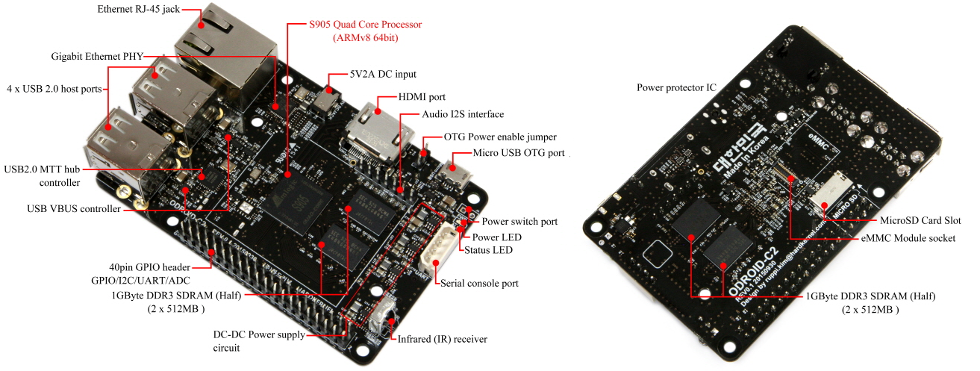
Additional hardware information:
One of the new ODROID-C2 features is SD 3.01 - a card reader compatible with the UHS-1 MicroSD standard, which many wanted and requested. As well as a faster eMMC controller and module, which can be ordered with ODROID-C2, and will be equipped with a pre-installed Ubuntu.
There is also a 40 + 7 pin GPIO. It includes the functions of PWM, I2C, I2S, UART, ADC and the GPIO itself.
A brief comparison of the specifications of the boards that you can buy for comparable money ($ 40):
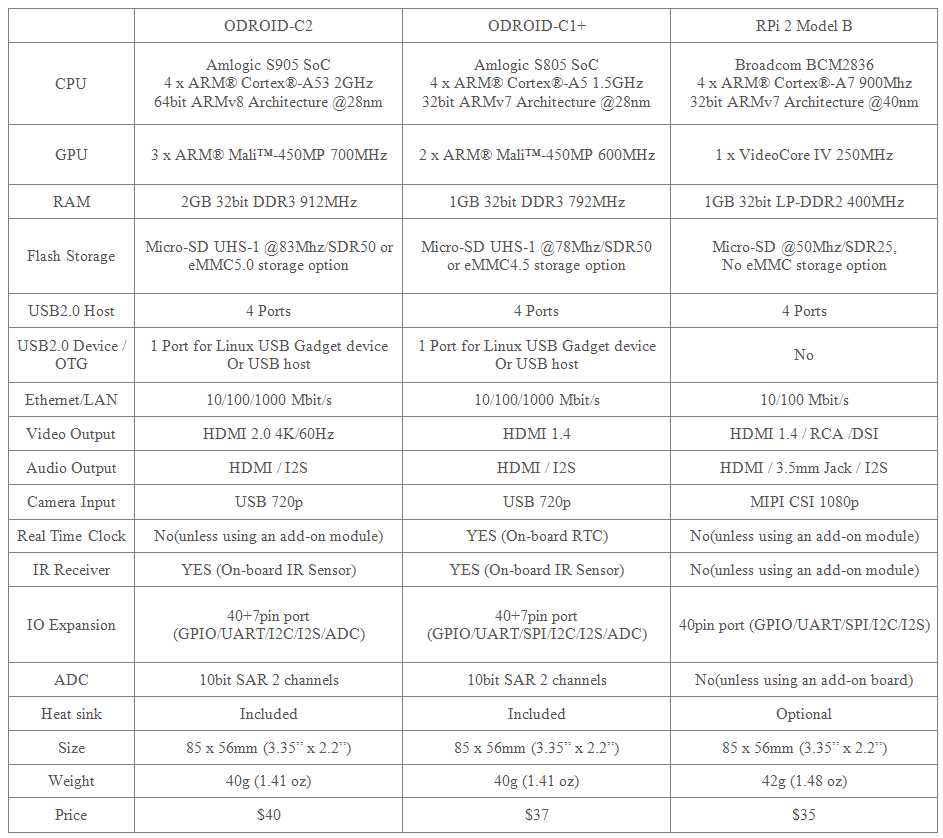
Performance: The
manufacturer launched several different tests for measuring computing power and comparison on Ubuntu 16.04, on different boards: Pi 2, ODROID-C1, ODROID-U3 and ODROID- XU4.
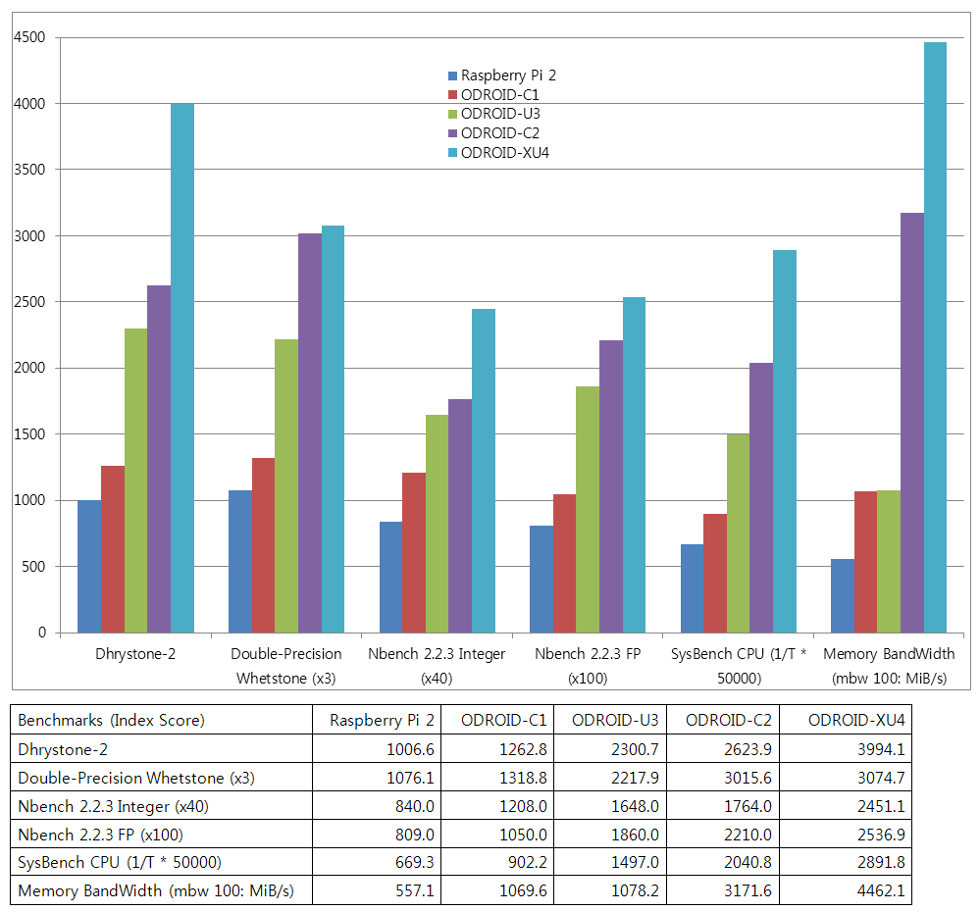
Or here are the Antutu test results for Android:
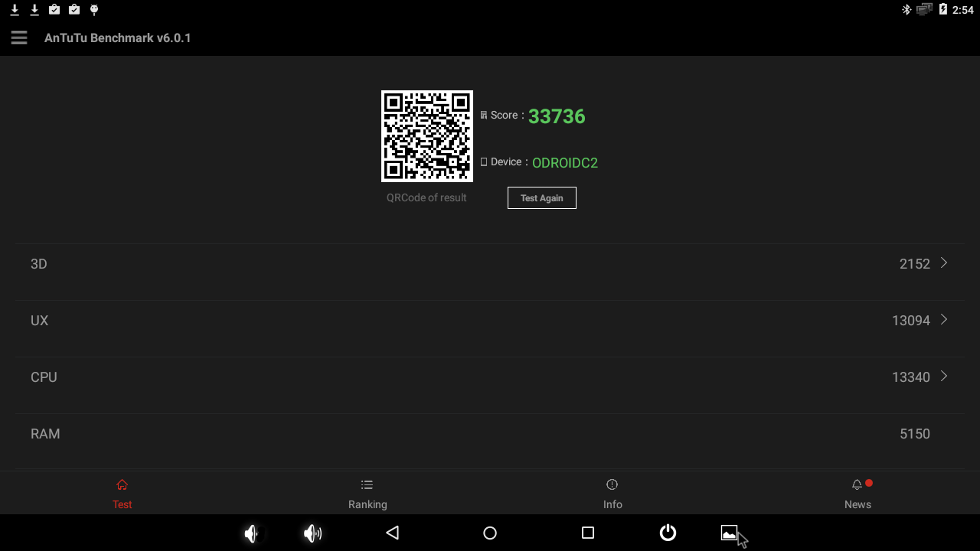
ODROID-C2 produces about 33700pts, while ODROID-C1 + for comparison shows about 21200pts. Note that the XU4 reaches 51000pts, thanks to the much faster A15 cores and the GPU chip Mali-T628 MP6 with 6 cores. But it also costs almost two and a half times more expensive. So ODROID-C2 is the undisputed leader in terms of price / performance.
Network connection:
On board C2 there is a gigabit network adapter. A bidirectional speed test showed approximately 900Mbps. Thanks to the doubled send buffer in S905, the speed of ordering doubled. Now it is a full gigabit adapter.
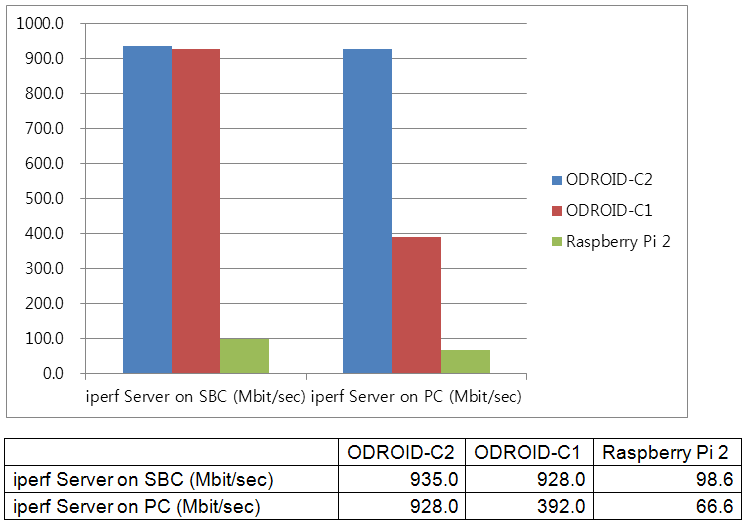
HDMI 2.0 and video playback:
The board supports 4K / 60Hz HDMI 2.0 output and gives you the opportunity to work in great UHD 3840x2160 resolution. But, unfortunately, not as fast as we would like. Rendering is noticeably slow.
Therefore, Android used the ability to multiplex the interface layer in the FHD 1920x1080 GUI and the video layer in the UHD 3840x2160, which allows you to work quickly and in high resolution.
The same approach will probably be applied to Linux in the future.
The same approach was used in the latest Kodi Jarvis-RC2 media processor, preinstalled in Android, and can achieve the same results right now.
Perhaps I will miss the screenshots in 4K, but if someone really needs it, here are the links to them:
dn.odroid.com/homebackup/20160203/scr1.png
dn.odroid.com/homebackup/20160203/scr2.png
Extras:
1. There is no SPI bus. The S905 chip simply does not. Additional SPI accessories unfortunately will not work with C2.
2. There is no RTC. The S905, again, simply does not have it. Perhaps the company will make an additional fee with such functionality.
3. Incorrect alpha blending fixed in S905. There is no longer any need to use DDX blending as a workaround.
4. The public version of the S905 specification will be released in March or April.
5. Ubuntu 16.04 (LTS) ARM64 is still very early and not quite ready for ARM64. It lacks some packages, for example Chromium. It is quite difficult to assemble for this architecture, and apparently no one has succeeded so far.
6. Ubuntu / Linux Mali GPU driver is only in the form of fbdev. The X11 version will be available in March or later in April.
7. OS images and assembly instructions are already available on the WiKi company http://odroid.com/dokuwiki/doku.php?id=en:odroid-c2
8. Prototypes were sent to enthusiasts from the community who proved their usefulness by pleasant and interesting designs for company products.
My personal impression:
And now starting from the 8th point, which by the way is the last in the whole announcement on the forum, if you read, there is nothing further there, I can say that I am just one of those who received the pre-release sample. I once wrote codecs for Exynos MFC so that Kodi can display video hardwarefully on many hardkernel boards, for this a company that sends me all the samples of its new products for a year, for which many thanks to it. A sample has already arrived at my post this Friday.
What can I say from my personal impressions: firstly, something that was not mentioned or was mentioned in passing in the announcement - now the board has full-size HDMI. No more hassle with micro-hdmi, especially if this is the first hardkernel board you bought. It is scary to remember how much I once soared once with U2 while I found this wire. The product itself, in my opinion, is one of the most ready-made releases of the company. Almost everything is working on it now. And the fact that it does not work is simply not ready for arm64 yet, but this is not a big problem. The GPU drivers started flawlessly. The video codec also did not cause any particular problems. Everything works very fast. What I especially liked was the working hotplug CPU governor, disabling processors that are not used, and lowering the dips. The last governor so working was in U2 / U3, then there were only those working with hertz.
I don’t have 4K, I don’t have to see how cool it is, and I don’t need to. I hardly notice the difference between 720p and 1080p, the TV is big, but I'm not sitting close to it. So this geek feature is passing me by.
The divine black color of the board. It looks very cool, such a small anthracite. Stylish. Very good full-time radiator. There is no cheap plastic cooler that so spoiled the impression with its noise on -XU? circuit boards.
From the fact that they did not mention it, the power connector is similar to C1, i.e. this is such a small pin, I don’t know what kind of connector it is, but I only have one such wire, which is rather inconvenient. It turns out that either this or that is included. The power consumption is apparently exactly the same, that is, a USB connector is enough. The board has never sagged or cut down from the same source that feeds C1, although I drove it strongly.
If in turn it is bad, then, in the opinion that I have developed, most of the problems stem from the total unavailability of software to arm64. The same Kodi I had to specifically fix to just assemble. Same thing with amllibs libraries. And all the improvements are the most banal carelessness of developers who wrote their software fully confident that the size of the pointer is 32 bits. All errors come from castes (void *) (unsigned int), thank God the compiler warns about this directly. Although, of course, more exotic options come across, but all the same, it all comes down to the fact that there used to be an int, and now long. And, nevertheless, technically - this product is very cool right at the start. And I really like him, taking into account that I reacted rather coolly to C1. True, the missing RTC is of course a little discouraging.
Without any problems, I will answer questions if you are interested in something specific that I can see or measure on the board. Despite the fact that this is an engineering sample, it looks very, very "released" and is unlikely to be very different in the version that will be delivered to consumers.
Well, a photograph of my sample, along with Kodi, with which I have to deal most with these boards.
